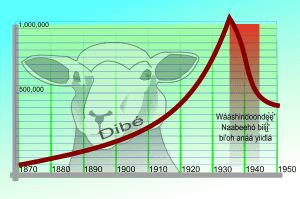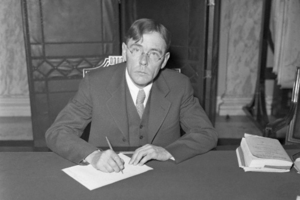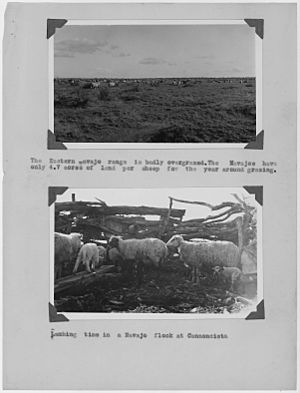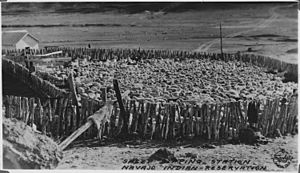Navajo Livestock Reduction facts for kids
The Navajo Livestock Reduction was a time in the 1930s when the United States government made the Navajo Nation reduce their animal herds. This happened during the Great Depression, a time when many people faced economic hardship.
The government said they needed to reduce the animals because the land was getting damaged. They believed too many sheep and other animals were causing erosion and making the grazing areas unhealthy.
Contents
Why the Government Wanted to Reduce Animals
In the 1930s, a forester named William Zeh worked for the Navajo Reservation. He saw that the land was suffering from serious erosion. Erosion happens when soil is worn away, often by wind or water. Zeh thought there were too many animals grazing, especially goats. He worried this would harm the Navajo way of life.
Around the same time, there was a big drought in the Midwest of the United States. Poor farming methods had made the land very dry and loose. This led to huge dust storms, turning the area into what was called the Dust Bowl. Thousands of people had to leave their homes because their farms were ruined.
In 1933, President Franklin D. Roosevelt chose John Collier to lead the Bureau of Indian Affairs (BIA). This government office works with Native American tribes. Collier had studied Native American issues and wanted to help improve their lives.
Collier agreed with Zeh and others that the Navajo land could not support so many animals. For example, the land could only support about 500,000 sheep. But in 1931, the Navajo people owned about 2 million sheep! These sheep provided half of the Navajo people's income. Some historians, like Lawrence A. Kuznar, have said that the government's reasons for the reduction were not very strong.
Long ago, Spanish explorers brought sheep and horses to North America. This was part of the Columbian Exchange, where new plants and animals were shared between different parts of the world. By the 1700s, the Navajo people had learned to use these new animals. They developed their own special sheep, called Navajo-Churro sheep, and raised horses.
In the 1800s, after fighting with the United States government, many Navajo animals were killed. The Navajo people were forced on a difficult journey called the Long Walk of the Navajo. They were held as prisoners for years.
In 1868, the U.S. government and the Navajo signed a treaty. This agreement allowed the Navajo people to return to their traditional lands. The treaty also gave each Navajo family two sheep, one male and one female. This helped them start their herds again.
The Navajo were very good at raising animals. Their herds grew a lot over the next 60 years. The government also made their reservation bigger and stopped outsiders from stealing from the Navajo. The Navajo sold their sheep's wool and made beautiful Navajo rugs and blankets. This encouraged them to have more sheep. The number of sheep grew from 15,000 in the 1870s to 500,000 in the 1920s.
For the Navajo, reducing their animals went against many of their traditions. It also took away their main way of earning money. The Navajo believed their livestock were sacred. They felt these animals were a gift from the Holy People.
The Government's Plan to Reduce Animals
The U.S. government decided that the number of animals on the Navajo reservation needed to be cut down a lot. Thomas Dodge, who was the chairman of the Navajo Nation Council, tried to explain the government's reasons to his people. But because the animals were so important to the Navajo culture and economy, most people did not agree with the plan.
John Collier approved a program that led to the government buying and removing more than half of the Navajo animals. The government officials did not fully understand how deeply the Navajo people cared for their herds. Many Navajo women, who often relied on their animals for income, suffered greatly. The Navajo people strongly opposed the program. However, Collier had some opponents arrested, which made it harder for them to stop the plan.
The Navajo people did not like this plan. After buying the animals, the government sent many to market or killed them on the reservation. At first, the program was "voluntary" in 1933. But by 1935, it became mandatory, meaning the Navajo had no choice.
The Navajo people called these events the "Second Long Walk." This was because the livestock reduction caused so much damage to their economy, their society, and their way of life.
Historian Brian Dippie wrote that the Indian Rights Association called Collier a "dictator." They said he caused a "near reign of terror" on the Navajo reservation. Dippie added that Collier became "an object of 'burning hatred'" among the very people he wanted to help. This livestock reduction made the Navajo strongly oppose other parts of Collier's Indian New Deal. This New Deal was a plan to help Native American tribes. It encouraged tribes to restart their own governments, stopped dividing up shared tribal lands, and supported Native American cultures.
What Happened After the Reduction
In the late 1930s, the government set limits on how many animals could be in different areas of the reservation. Navajo families were given quotas, or limits, for their animals in each area. In the 1950s, the Navajo Tribal Government took over managing this quota system. By 1967, there were about 600,000 'sheep units' (a way to count different types of animals). This system of limiting livestock is still used today.
Images for kids











